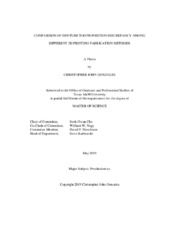| dc.description.abstract | Statement of problem. 3D-printed denture workflows have been introduced and are continuing to emerge in modern dentistry, however there are few studies evaluating the effect on denture tooth position when using 3D-printing fabrication techniques. Purpose. The purpose of this in vitro study was to investigate the tooth positional discrepancy of dentures made by 3D-printing technology.
Material and methods. A stone cast of an edentulous maxilla was selected and scanned by a laboratory scanner to generate a total of 30 maxillary dentures (n=10 per group); 3D-printed denture bonded with card teeth (CT), monolithic 3D-printed denture (MP), and 3D-printed denture bonded with 3D-printed teeth (PT). The assembled specimen scan files of each denture were aligned by using a software program for 3D analysis. Measurements were made at 64 locations, allowing evaluation of denture tooth discrepancy in an occlusal, buccal, lingual, and mesial-distal direction. In addition, posterior and anterior regions were compared in terms of tooth discrepancy. The median and interquartile range values were used to assess accuracy and reproducibility. Levene and Kruskal-Wallis statistical tests were used to evaluate differences among the three groups.
Results. For the overall tooth discrepancy analysis, there were statistically significant differences among all three groups (P<.05). The monolithic 3D-printed denture group showed the lowest tooth discrepancy, followed by 3D-printed denture bonded with card teeth, and 3D-printed denture bonded with 3D-printed teeth. For directional discrepancy analysis, the values of occlusal tooth discrepancy were significantly larger than the other three types of discrepancy for all three groups (P <.05). No significant difference between posterior and anterior region discrepancies was demonstrated (P >.05). Conclusions. Monolithic 3D-printed dentures produced the highest values of accuracy and reproducibility in comparison with 3D-printed denture bonded with card teeth and 3D-printed denture bonded with 3D-printed teeth. The values of occlusal tooth discrepancy were significantly larger than the other three directions of tooth discrepancy. | en |


